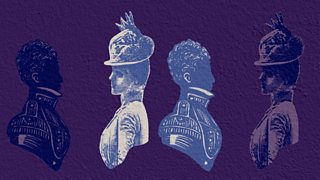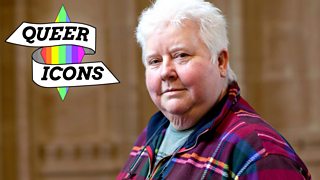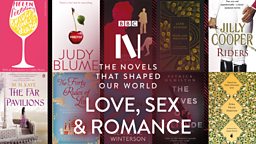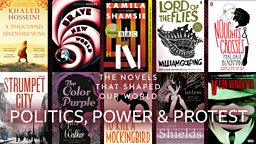Rule Breakers: Ten novels that broke the mould
The characters in this month’s set of novels are breaking all kinds of rules and challenging our perceptions of life itself. From rebelling against the government as in George Orwell’s modern classic Nineteen Eighty-Four, to examining gender and sexuality in Orlando by Virginia Woolf or Ali Smith’s How to Be Both, join these authors in breaking convention and challenging expectations.

The panel have chosen these novels on the theme of Rule Breakers:
A Confederacy of Dunces by John Kennedy Toole; Bartleby, the Scrivener by Herman Melville; Habibi by Craig Thompson; How to Be Both by Ali Smith; Nights at the Circus by Angela Carter; Nineteen Eighty-Four by George Orwell; Orlando by Virginia Woolf; Psmith, Journalist by P.G. Wodehouse; The Moor’s Last Sigh by Salman Rushdie; Zami: A New Spelling of My Name by Audre Lorde.
The Novels Survey
-
![]()
Contribute to a people's list of rule-breaking novels and get personalised book recommendations.

A Confederacy of Dunces by John Kennedy Toole, 1980

Ignatius Reilly is a 30-year-old “slob extraordinary”; an unemployed medieval philosophy scholar with a strong hatred of the modern world, living with his mother. When he gets into a drunk-driving accident, he is forced to get a job to pay for the damage. Clad in his iconic hunting cap, Ignatius roams 1960s New Orleans encountering a cast of comic characters on his way.
Book Club Questions
1. How does the use of third-person narrative add to the comedy of the book? What effect do the first-person segments from Ignatius have?
2. How is misogyny presented throughout the novel? How does Ignatius’ relationship with his mother play into this?
3. What do you think of Ignatius? Do you like him? How does this impact your enjoyment of the book?
-
![]()
LISTEN & BAKE: Cult Fiction and Food
Dan Saladino looks at food in cult fiction, including John Kennedy Toole's character Ignatius and his legendary appetite for the junk food of New Orleans.
-
![]()
LISTEN: 100 Books You Must Read Before You Die - A Confederacy of Dunces
Author Cherry Mosteshar adds A Confederacy of Dunces by John Kennedy Toole to the list.
Get Involved

Bartleby, the Scrivener by Herman Melville, 1853

Wall Street lawyer hires Bartleby as a scrivener. Although he starts well, Bartleby gradually refuses to perform certain tasks, then his job, and finally to do anything at all, justifying himself with the words “I would prefer not to.”
Book Cub Questions
1. What meaning do you attribute to the use of the word “prefer” in Bartleby’s refusal?
2. Compare Bartleby and the narrator. Who do you think is the hero of this story and who is the antihero? How do they differ?
3. Walls have a strong symbolic presence in the story, for example the wall Bartleby’s window overlooks or the wall the narrator finds himself facing in the Halls of Justice and by which he dies. What do the walls represent?
-
![]()
LISTEN: The Strange Journey of Herman Melville
A 1991 Omnibus profile of author and one-time sailor Herman Melville, who fell out of favour during his lifetime and whose reputation was only re-established after his death.
Get Involved

Habibi by Craig Thompson, 2011

Dodola and Zam are two escaped child slaves living in a boat in the desert. As the story unravels, we follow them through different scenarios in a fictional landscape, the cruelty and harshness of which are blended with the fantastic tales Dodola recounts to Zam.
Book Club Questions
1. The narration weaves together the adventures of the protagonists and the stories from the Koran that Dodola tells to Zam. What effect does this writing style create?
2. How does the author integrate the Arabic language in his drawing? What’s the meaning of his pictorial use of words?
3. Many of the characters Zam and Dodola meet each have specific views on life. Which characters did you find most interesting and why?
Get Involved

How to be Both by Ali Smith, 2014

How to Be Both is a passionate, playful novel about art, gender and sexuality. It tells two interconnected stories, with one half of the book following a fifteenth century Italian fresco painter and the other following a grieving sixteen-year-old in contemporary England. Two versions of the book have been printed, alternating the order of the stories so readers can have different experiences of the same text.
Book Club Questions
1. In what ways does the novel suggest that one “can be both”? e.g. gender identity, sexual identity, young and old, dead and alive?
2. The two halves tell different stories set in very different times, but what are some of the ways in which they are interconnected?
3. Half of the copies of this book were printed with George’s story first, the other half with Francesco’s story first, so readers would have different experiences. Which version did you read, and how do you think the experience would have been different if you had read the other half first?
-
![]()
LISTEN: A book of two halves
Ali Smith talks to Mariella Frostup about her novel - set in the present day and the fifteenth century - about love, loss and the redemptive power of art.
-
![]()
READ: Q&A - Ali Smith on How to be Both
Smith says, “It struck me as extraordinary that we can be looking at a surface and think we can see everything, but actually there's something below it - and we can't see it.”
Get Involved

Nights at the Circus by Angela Carter, 1984

Is she fact or is she fiction? So goes the slogan of Fevvers, the Cockney Venus, aerialist extraordinaire, part-swan, part-woman. Jack Walser is an American journalist sent to find about more about the infamous trapeze artist. Intrigued by this feathered enigma, he soon finds himself joining the circus on a fantastical journey through London, St Petersburg and Siberia as the world rapidly hurtles towards a new century.
Book Club Questions
1. Angela Carter was a boldly original feminist writer, weaving together traditional myths and fairy tales with progressive ideas about female sexuality and independence. How do the female characters in Nights at the Circus reflect this?
2. The novel is set at the turn of the nineteenth century when the world is on the brink of change and disruption. In addition to its setting, how else does the novel explore the theme of transformation?
3. How does Carter's use of vivid imagery and evocative language add to our reading of the story?
-
![]()
READ: Radical writing - Was Angela Carter ahead of her time?
Exploring the surreal imagination of this outspoken author of short stories and novels, with contributions from Margaret Atwood, Jeanette Winterson, Anne Enright and Salman Rushdie.
-
![]()
WATCH: Nights at the Circus
Kelly MacDonald reads from Nights at the Circus, the audacious story of a winged acrobat.
Get Involved

Nineteen Eighty-Four by George Orwell, 1949

Winston Smith lives in London under a totalitarian regime led by the Big Brother, a mysterious leader controlling the population’s actions and thoughts. When Winston falls in love with Julia, the two start a clandestine relationship outside the eye of the Big Brother in an attempt to secretly rebel against the government.
Book Club Questions
1. Do you think some features of Nineteen Eighty-Four are more relevant to now as opposed to when it was published in 1949? Which do you think are more specifically related to that historical period?
2. What is the rationale behind the social class system presented in the book? Why is the so-called “prole” not subject to the same rules imposed on the outer and inner party members?
3. Why has Orwell decided to present this dystopia through the eyes of Winston, an employee of the Ministry of Truth?
-
![]()
LISTEN: The Road to Nineteen Eighty-Four
David Aaronovitch traces how a decade of political chaos shaped Orwell's vision of a totalitarian future.
-
![]()
WATCH & LISTEN: The Real George Orwell
Radio 4's major series for January 2020 exploring Eric Blair the man, and George Orwell the writer.
Get Involved

Orlando by Virginia Woolf, 1928

Virginia Woolf’s Orlando skewers concepts of gender through the fictional biography of its eponymous character who, after first living for several decades as a young nobleman, awakens one day as a woman called Lady Orlando. In Orlando’s overnight change of sex, Woolf playfully explores the ways masculinity and femininity define one’s life and how they were defined in society from the time of Elizabeth I through to the early twentieth century.
1. How and why does Woolf play with androgyny and societal expectations of gender through the characters of Orlando/Lady Orlando, the Archduchess Harriet/Archduke Harry, Sasha and Shelmerdine?
2. What does Orlando’s experience of 300 years of life say about the way our experiences of memory and time change as we age?
3. Does the book read more like a novel or a biography? How and why does Woolf satirise the conventions of both forms of writing?
-
![]()
����ý SOUNDS BOX SET: Orlando by Virginia Woolf
Listen to Virginia Woolf’s comic biography of a time-travelling hero who transforms into a heroine.
-
![]()
LISTEN: Val McDermid champions Orlando
McDermid chooses Virginia Woolf's novel for Queer Icons, ����ý Radio's celebration of LGBTQ culture.
Get Involved

Psmith, Journalist by P. G. Wodehouse, 1915
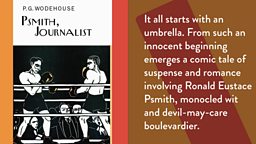
Psmith, an old Etonian and Cambridge student, finds himself at a loose end while on holiday in New York. Following a chance encounter with Billy Windsor, acting editor of Cosy Moments magazine, Psmith encourages Billy to transform Cosy Moments into a campaigning paper which exposes the misdeeds of an unscrupulous landlord of slum tenements. This leads to the pair crossing paths with the notorious gangs of New York in their quest for justice.
Book Club Questions
1. To what extent does Psmith embrace Marxist ideology in his campaign to help the slum tenants?
2. The novel was written shortly after Wodehouse’s first visit to the USA. What impression does it give of ‘jazz age’ New York?
3. To what extent do you think that Psmith’s campaign is aided or hindered by the fact that he is not American, that he is an outsider?
-
![]()
LISTEN: Stephen Fry on PG Wodehouse
Stephen Fry nominates his hero, PG Wodehouse, who "just simply cheers him up", for the Great Lives series.
-
![]()
WATCH: Robert Webb on PG Wodehouse plots - “trying to unpick a spider’s web wearing boxing gloves”
Actor Robert Webb, who starred as Bertie Wooster in Perfect Nonsense, reads from The Code of the Woosters.
Get Involved

The Moor’s Last Sigh by Salman Rushdie, 1995

Set in twentieth century India, The Moor’s Last Sigh brings together different cultures, religions and historical allegories to tell the story of one family through the generations. It explores their love and their problems, focusing on "the Moor”, who ages at twice the normal speed.
Book Club Questions
1. The Moor lives his life at twice the speed of everyone around him. Do you think this is important to his character and the wider story?
2. Rushdie uses key historical events in Europe and India throughout the novel. What relevance do these have to the novel?
3. Discuss the role of women in the novel. How does the Moor relate to women, in particular his mother?
-
![]()
WATCH: Salman Rushdie on realism
Appearing at the Hay Festival in 2016, Salman Rushdie discussed the nature of realism between the reader and the writer.
-
![]()
LISTEN: James Naughtie and Salman Rushdie discuss his Booker Prize-winning novel Midnight's Children
Midnight's Children, which takes the moment of India's Independence as its starting point, won Salman Rushdie the Booker Prize in 1981.
Get Involved

Zami: A New Spelling of My Name by Audre Lorde, 1982

Zami: A New Spelling of My Name is an autobiography mixed with myth and fiction by the black, lesbian poet Audre Lorde. It contains stories starting from her birth in Harlem in the 1930s and her subsequent adventures as she comes of age, her friendships and lovers. It paints a vivid picture of mid-century America, especially New York, its attitudes to a young Black woman, and her undiminished enjoyment and confrontation of the challenges thrown at her.
Book Club Questions
1. This novel is subtitled ”A Biomythography” – does the fact that this is a mix of autobiography and myth impact how your read the novel?
2. How do you think life has changed in the last eighty years for a Black girl growing up in poverty and coming from a family that has only relatively recently immigrated?
3. Does Lorde see herself as more marginalised by her Blackness, or her lesbianism?
-
![]()
LISTEN: The enduring influence of Audre Lorde
Poet Jackie Kay and performer Selina Thompson on the influential US writer and civil rights activist, whose work considers feminism, lesbianism, civil rights and black female identity.
-
![]()
LISTEN: Audre Lorde's importance to contemporary activists
In 2017 on Radio 4's Front Row, academic Akwugo Emejulu discussed the resurgent interest in Lorde's work and her importance to contemporary activists, as Lorde anthology Your Silence Will Not Protect You was published in the UK.
Get Involved

Book Club Questions on Rule Breakers
To round off our 10 novels in the Rule Breakers theme, here are five stimulating questions to ponder. And below, to continue exploring, try our further reading suggestions.
1. Not all the titles in this set of books are traditional novels; Bartleby, the Scrivener is a short story, Habibi is a graphic novel and Zami: A New Spelling of My Name is a ‘biomythography’. Why do you think they have been included in this list of novels?
2. Are there any other writers you can think of who could be seen as rule breakers?
3. Do you enjoy reading novels that challenge your views of society?
4. Do you think it’s important to read outside of your comfort zone? If so, why?
5. Throughout history, many works of literature have been banned in particular countries or parts of society for spreading controversial ideas that oppose cultural hegemony. Do you think it’s right that books are banned?
More novels exploring rule breakers
Fahrenheit 451 by Ray Bradbury
Paul Takes the Form of a Mortal Girl by Andrea Lawlor
Animal Farm by George Orwell
The Grapes of Wrath by John Steinbeck

The Novels Survey
-
![]()
Contribute to a people's list of rule-breaking novels and get personalised book recommendations.

- Produced with support from
- Most of the books on the Novels 100 list are available in various formats from the .

- Novels That Shaped Our World is run in partnership with and is supported by .
Get Involved
-
![]()
Share the book you love on Twitter
-
![]()
Tell us about the novels you love on Facebook
-
![]()
Show us a book (or books) you love using the hashtag #mybooklife
Brilliant books content on ����ý iPlayer
-
![]()
Novels That Shaped Our World
Looking at class in all its shapes and sizes, from all sides of the class divide, in the UK, USA and India
-
![]()
Everything Is Connected - George Eliot's Life
Gillian Wearing's experimental film, made up of a diverse cast of people, celebrate the legacy of the Victorian author
-
![]()
Face to Face: Maya Angelou
In this classic interview from 1994, Jeremy Isaacs talks to Maya Angelou about her life, her writing and her hopes for the future













